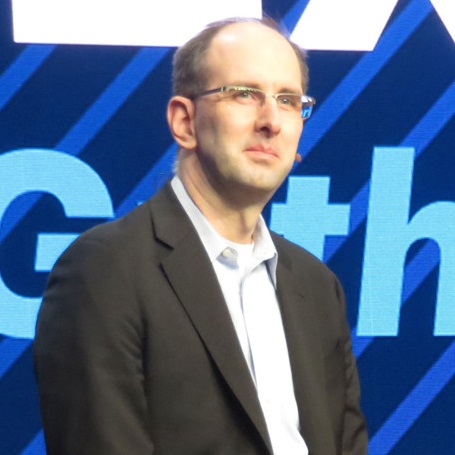Forward Thinking Blog Microsoft’s Cloud: How the Company “Eats Its Own Dog Food”
At the Gartner Symposium last week, Microsoft Executive Vice President Scott Guthrie, who leads the company’s Cloud and AI efforts, discussed Microsoft’s own cloud journey. I was particularly intrigued by some of the things he said Microsoft has learned about running enterprise applications in the cloud.
Trading his trademark red polo shirt for a sport coat, Guthrie was interviewed at the Symposium by Gartner’s Ed Anderson. The biggest question for Microsoft? “How do we keep transforming the products and services we offer, [as well as] the culture?” This includes meeting customers in a multi-cloud world, embracing open source, working with traditional partners like SAP and Adobe as well as new partners, and focusing on customer success by being a trusted provider.
Guthrie said Microsoft has long had a tradition to “eat our own dog food,” which means it runs its own systems on top of the same software it offers to customers. Microsoft IT was an early customer for Office 365, Azure, and Dynamics 365, and has moved the vast majority of its internal servers to Azure, including its SAP implementation, payment systems, and test systems. This has helped Microsoft learn what it takes to run the technology on an enterprise scale.
Every organization is going through digital or business transformation, and according to Guthrie, we “need to make AI integral to everything.” His team not only builds many core AI platform capabilities and deploys them as services everyone can use, but also incorporates them to drive business process or productivity improvements through AI insights in Power BI, Office, and the business applications.
On cloud, he said that many people think of it as Infrastructure-as-a-Service—like Azure or Amazon Web Services—and while that’s important, it’s equally important to think about Software-as-a-Service and how you manage running all of these things together. Microsoft is taking an “end-to-end view” as opposed to thinking only about virtual machines or networking. The company wants to have the best-of-breed “Lego blocks” (specific services, such as cloud-scale databases), and is also trying to solve the problem of combining these “Lego blocks” to build a solution.
For example, he said the problem with AI isn’t just AI programming, but getting your data into a common data platform where you don’t have anomalies—which can be 80 percent of the effort. Microsoft is working with Adobe and SAP to take their data and combine it with data from Dynamics and Office 365 into a common platform known as the Open Data Initiative. (This was announced at the Build conference last month.) He acknowledged this doesn’t solve the problem completely, but it helps.
Asked about contracting and licensing and how some organizations have found that costs were higher than they had anticipated, Guthrie directed organizations to take a number of steps. The first is to know what you are spending, because there are lots of different services, and Microsoft is working on a “single piece of glass” to make it easier to understand. The second step is to optimize your spending and make sure you are following best practices. Here, Microsoft is creating tools to give you cost visibility, and flag where you are overspending, such as spinning up VMs that are rarely used or overprovisioning databases.
In Microsoft’s own “journey to the cloud,” two things were “eye-openers.” Five years ago, the company said it would move its SAP environment to the cloud, but actually found it was the first system to move because the cloud made it much easier to spin up and down development and test environments. This turned out to be “the single biggest benefit” and had a “fantastic ROI.” The second? Simply “turning stuff off.” Unless systems are flagged for production, Microsoft would turn them off at 6 p.m. on Friday. Not only did this save money, but about half the systems were never turned on again. This unlocked “enormous savings,” Guthrie said.
When you take advantage of elastic database models—scaling up as you need and scaling down where you don’t—you can “unlock a lot of value.” Guthrie noted that Azure has a tool to identify workloads you could optimize by moving to the cloud, but said that often you can take costs out of a system as you’re migrating it, and then reinvest the money saved to improve the system.
Most people in the audience indicated they were running both Azure and AWS, and Guthrie responded that “hybrid and multi-cloud is a reality that every enterprise will face.” Microsoft thinks of hybrid as not just the existing data center and Azure, but also as including multi-cloud and edge systems.
On other topics, he said that Azure runs more VMs that are Linux-based than Windows-based, and Microsoft is making sure its entire portfolio runs well on Linux, including SQL Server and .NET. Unsurprisingly, Microsoft also “love(s) Windows as well.” Asked if it would offer its own version of Linux, he said Microsoft had great partnerships with Red Hat, Canonical, and Suse.
Guthrie said he thought traditional data centers would be obsolete in 5-8 years; at that point, everything will be running in the cloud. He believes cloud costs will continue to decrease, and agreed that “platform lock-in” on the cloud is a legitimate concern.
Cloud was a huge disruption for business. AI will be just as big, he said, but will affect more businesses and be less of a tech disruption and more of a business and societal disruption.

